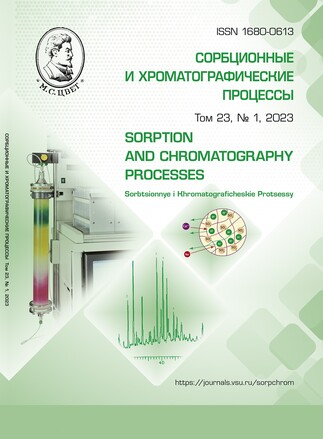Solid-phase spectroscopic determination of copper (II) ions using a modified anion exchanger
Abstract
Copper is a vital micronutrient for humans with an important physiological role. However, an excessive level of this element can lead to pathological changes in the body. It is not always possible to directly measure the content of this element at the MPC level and below in food and water using common methods, due to the influence of the matrix composition of the samples. As a result, methods for determination of low concentrations of copper in various objects are of great interest. One of these methods involves the application of selective polymeric complexing sorbents and solid-phase spectrophotometry, which provide selectivity and efficiency in the concentration of various substances from objects of complex composition.
The purpose of this study was the synthesis of a sorbent modified with a chelating reagent for the solid-phase spectroscopic determination of Cu(II) ions. This was achieved by modifying highly basic anion resin via immobilization of 2-hydroxy-2′-carboxy-5-sulfoformazylbenzene – zincone on it, as well as optimization conditions of concentration and extraction of copper (II) ions by the obtained sorbent.
The conditions for the immobilization of the reagent on an anion-exchange resin brand AB-17-8: acidity (pH 2-10), phase contact time (τmin=25 min), optimal capacity for zincon (CECCN=340 mg/g) were studied. Taking into account the obtained data, a modified sorbent AB-17-CN was synthesized. The conditions for the concentration of copper (II) were determined for AB-17-CN (pH=5.5±0.5, τmin=10 min) and achievable capacity (CECCu(II)=31.2 mg/g). Diffuse reflectance spectra were obtained for all components and their systems, and the corresponding absorption peak for the complex was established at wavelength λAV-17-CN-Cu= 700 nm, for which there was no influence of absorption by other AB-17-8 and AB-17-CN components. The study demonstrated the possibility of using AB-17-CN for the solid-phase spectroscopic determination of Cu(II) in the concentration range 0.02 – 0.2 mg/dm3with a detection limit of 0.015 mg/dm3. The correctness of the results was checked by the "introduced-found" method and independent atomic absorption method. The applicability of the proposed method for the analysis of the natural water was demonstrated.
Downloads
References
Leal P.P., Hurd C.L., Sander S.G. et al. Copper pollution exacerbates the effects of ocean acidification and warming on kelp microscopic early life stages. Sci Rep. 2018; 8: 14763. https://doi.org/10.1038/s41598-018-32899-w
Rehman M., Liu L., Wang Q. et al. Copper environmental toxicology, recent advances, and future outlook: a review. Environ Sci Pollut Res. 2019; 26: 18003-18016. https://doi.org/10.1007/s11356-019-05073-6
Li J.-J., Ji C.-H., Hou C.-J., Huo D.-Q., Zhang S.-Y., Luo X.-G., Yang M., Fa H.-B., Deng B. High efficient adsorption and colorimetric detection of trace copper ions with a functional filter paper. Sens. Actuators, B. 2016; 223: 853-860. https://doi.org/10.1016/j.snb.2015.10.017
Teow Y.H., Kam L.M., Mohammad A.W. Synthesis of cellulose hydrogel for copper (II) ions adsorption. J. Environ. Chem. Eng. 2018; 6: 4588-4597. https://doi.org/10.1016/j.jece.2018.07.010
Hashem E.Y., Seleim M.M., El-Zohry A.M. Spectrophotometric determination of copper (II) in pharmaceutical, biological and water samples by4-(2′-benzothiazolylazo)-salicylic acid. Journal of Applied Spectroscopy. 2011; 78: 586-593. https://doi.org/10.1007/s10812-011-9502-1
Alharthi S.S., Al-Saidi H.M. Spectro-photometric determination of traceconcen-trations of copper in waters using the chromogenic reagent 4-amino-3-mercapto-6-[2-(2-thienyl)vinyl]-1,2,4-triazin-5(4H)-one: synthesis, characterization, and analytical applications. Appl. Sci. 2020; 10: 3895.
Oguz Ö, Meliha B.G., Caglar B., Ömer I. Electroanalytical Determination of Copper(II) Ions Using a Polymer Membrane Sensor. J. Electrochem. Sci. Technol. 2022; 11: 66-74. https://doi.org/10.33961/jecst.2022.00661
Abdolmohammad-Zadeh H., Has-sanlouei S., Zamani-Kalajahi M. Preparation of ionic liquid-modified SiO2@Fe3O4 nanocomposite as a magnetic sorbent for use in solid-phase extraction of zinc(II) ions from milk and water samples. RSC Advances. 2017; 7: 23293-23300. https://doi.org/10.1039/C7RA02126G
Kostenko E.E., Shtokalo M.I. Solid-phase spectrophotometry as an efficient method for the determination of heavy metals in foodstuffs. Journal of Analytical Chemistry. 2004; 59(12): 1158-1164. https://doi.org/10.1023/B:JANC.0000049716.57228.34
Skorykh T.V., Maslakova T.I., Pervova I.G., Lipunov I.N. Primenenie tverdofaznoi sistemy "silikagel'-getarilformazanat" dlia sorbtsionnoanaliticheskogo opredeleniia ionov toksichnykh metallov. Sorbtsionnye i Khromatograficheskie Protsessy. 2012; 12(2): 205-213. (In Russ.)
Gavrilenko N.A., Saranchina N.V., Gavrilenko M.A. Solid phase spectrophotometric determination of selenium(iv) using dithisone immobilized in a polymethacrylate matrix. Analytics and Control. 2014; 18(4): 424-429. (In Russ.)
Komissarenkov A.A., Fedorova O.V. Sorbtsionnye tekhnologii. Opredelenie svoistv sorbentov: uchebno-metodicheskoe posobie. SPb: SPbGTURP, 2015. 44 p. (In Russ.)
Volkov V.A. Kolloidnaia khimiia. Poverkhnostnye iavleniia i dispersnye sis-temy. Uchebnik. 2-e izd., ispr. SPb.: Lan', 2015. 660 p.
Garmash A.V., Sorokina N.M. Metrologicheskie osnovy analiticheskoi khimii. M.: MGU, 2012. 47 p.
Postanovlenie Glavnogo gosudarstvennogo sanitarnogo vracha RF ot 26.09.2001 N 24 (red. ot 28.06.2010) "O vvedenii v deistvie Sanitarnykh pravil" Available at: https://71.rospotrebnadzor.ru/upload/iblock/dc9/dc9696d129043734cfc9d6886e48d33e.pdf (accessed 12 May 2022).
Kostenko E.E. Tverdofaznoe spektrofotometricheskoe opredelenie medi (II) s primeneniem metiltimolovogo sinego. Zavodskaia laboratoriia. Diagnostika materialov. 2008; 74(1): 9-13. (In Russ.)
Gavrilenko N.A., Saranchina N.V., Gavrilenko M.A. The determination of copper(II) using neocuproine immobilized in a polymethacrylate matrix. Analytics and Control. 2016; 20(4): 330-336. https://doi.org/10.15826/analitika.2016.20.4.001
Shvoeva O.P., Dedkova V.P., Savvin S.B. Adsorption-spectroscopic method for multielement analysis: Determination of Cr(VI), V(V), Ni(II), and Cu(II) from one sample using a two-layer adsorbent. Jour-nal of Analytical Chemistry. 2010; 65(7): 699-703. https://doi.org/10.1134/S1061934810070075 (In Russ.)







